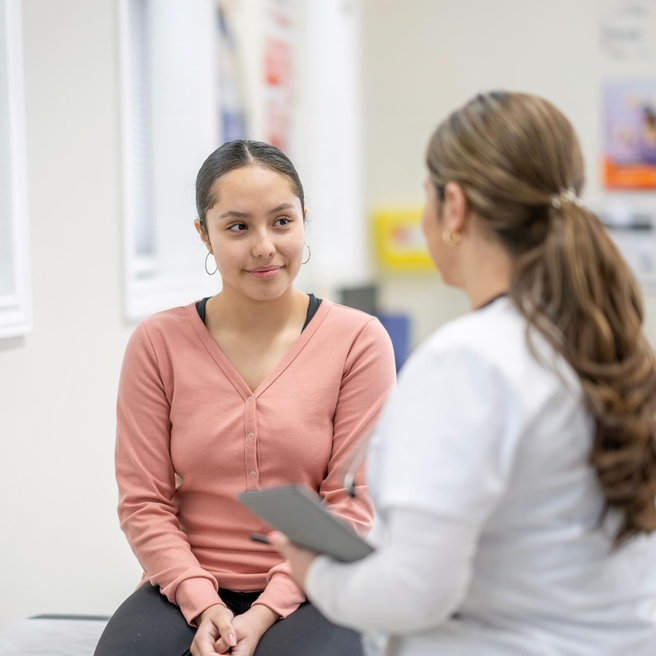What is dysmenorrhea?
Dysmenorrhea is a menstrual condition marked by severe and frequent menstrual cramps and pain associated with menstruation. It may be classified as primary or secondary.
In primary dysmenorrhea, symptoms are caused by uterine contractions which usually begin during adolescence, after the start of menstrual cycles, and may be a lifelong condition.
In secondary dysmenorrhea, symptoms are caused by another medical condition present in the body, such as pelvic inflammatory disease or endometriosis, and usually have a later onset.
While dysmenorrhea can affect any adolescent or young person, the risk increases for those who smoke, drink alcohol during their period, are overweight, and those who start menstruating before age 11.
Painful menstrual cramps can be debilitating, affect daily activities, and may be a symptom of a more serious condition. For these reasons, it’s important to be assessed by an experienced clinician who has expertise treating young people with menstrual issues.
Signs and symptoms of dysmenorrhea
Symptoms of dysmenorrhea vary and each young person may experience the symptoms differently. The following are the most common signs of dysmenorrhea.
- Cramping in the lower abdomen
- Pain in the lower abdomen and/or lower back
- Pain radiating down the legs
- Nausea, vomiting and/or diarrhea
- Weakness
- Fainting
- Headaches
The symptoms of dysmenorrhea may resemble other conditions or medical problems. Always consult the adolescent's healthcare provider for a diagnosis.
Causes of dysmenorrhea
The cause of dysmenorrhea depends on whether the condition is primary or secondary.
In general, people with primary dysmenorrhea experience uterine contractions as a result of a chemical imbalance in the body, particularly prostaglandin and arachidonic acid, chemicals which control the contractions of the uterus.
Secondary dysmenorrhea is caused by other medical conditions, most often endometriosis, a condition in which tissue that looks and acts like endometrial tissue becomes implanted outside the uterus, usually on other reproductive organs and causes internal bleeding, infection and pelvic pain.
Other possible causes of secondary dysmenorrhea include:
- Pelvic inflammatory disease (PID)
- Uterine fibroids
- Abnormal pregnancy (for instance, miscarriage, ectopic)
- Infection, tumors, or polyps in the pelvic cavity
Diagnosis and testing
Adolescents with dysmenorrhea should be referred to clinicians who have expertise in Adolescent Medicine. At Children’s Hospital of Philadelphia (CHOP), these young people are evaluated by our Adolescent Medicine specialists.
At CHOP, diagnosis of dysmenorrhea begins with a series of questions about the patient’s overall medical history, menstrual cycle, symptoms, and any sexual activity. A physical examination follows, which may include a pelvic examination.
At Children’s Hospital of Philadelphia, we welcome parents and caregivers as key partners in supporting a young person’s care during and after treatment for dysmenorrhea.
To help young people develop the skills needed to be responsible for their own health, clinicians typically ask to spend time alone with patients during each visit. This helps young people become comfortable talking with their healthcare providers about their concerns and allows patients to ask questions that may be more difficult to say in front of their parents and caregivers. We respect the privacy and confidentiality of our young patients, while ensuring that young people are safe and connected to the appropriate services and resources they need.
Because a diagnosis of dysmenorrhea can only be certain when other potential causes for the symptoms are ruled out, additional tests may be needed. These tests may include:
- Ultrasound, which uses high-frequency sound waves to produce images of organs and soft tissues inside the body. The images are viewed live and continually on a computer screen to determine if reproductive organs are present, shaped normally, and blood is flowing properly.
- Magnetic resonance imaging (MRI), which uses a combination of large magnets, radiofrequencies and a computer to produce detailed images of organs, soft tissues, muscles, ligaments and other structures within the body. Your child is not exposed to radiation during an MRI.
Treatment for dysmenorrhea
Treatment for dysmenorrhea may require a coordinated approach. At Children’s Hospital of Philadelphia (CHOP), Adolescent Medicine specialists work closely with specialists from endocrinology, radiology, surgery and others if needed to accurately diagnose and treat young people with menstrual issues.
Treatment for dysmenorrhea will be determined by the adolescent's physician based on:
- The adolescent's age, overall health and medical history
- Extent of the condition
- Cause of the condition (primary or secondary)
- The adolescent's tolerance for specific medications, procedures or therapies
- Expectations for the course of the condition
- The adolescent's opinion or preference
At Children’s Hospital of Philadelphia, treatment for dysmenorrhea often begins with counseling with an Adolescent Medicine specialist who can help the adolescent to better understand their condition and what they can do to improve symptoms.
For some young people, making simple lifestyle changes can help to reduce the frequency and intensity of dysmenorrhea symptoms. These changes may include regular exercise, a well-balanced diet and decreases in sugar and caffeine, adequate sleep and rest, smoking avoidance, and activities to lower stress levels.
For patients who are not helped by lifestyle changes, treatment for dysmenorrhea may include:
- Nonsteroidal anti-inflammatory medications, such as ibuprofen or aspirin
- Acetaminophen
- Hormonal medications
- Vitamin supplements
- Heating pad across the abdomen
- Hot bath or shower
- Abdominal massage
Resources to help
Adolescent Medicine Resources
We have created resources to help you find answers to your questions about health issues that become more relevant during your child's teen years.
